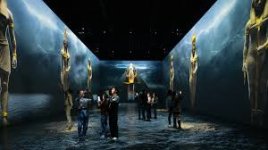Museums have long been a place to preserve, showcase, and interpret culture and history. But in the digital age, museums are not just physical buildings filled with artifacts. Thanks to advances in computer graphics, the traditional museum experience is evolving into interactive, immersive 3D environments that anyone can access from anywhere in the world.
Interactive 3D museum experiences leverage computer graphics to simulate real or imagined spaces. Whether it's walking through an ancient Roman street, exploring a digitally reconstructed dinosaur habitat, or virtually touching a Van Gogh painting, these experiences bring education, entertainment, and accessibility to a whole new level.
Unlike static 360° virtual tours, interactive 3D museum experiences are dynamic environments built using advanced graphics software. Users can:
These features combine education with engagement, making learning more effective and enjoyable.
Designing such immersive environments requires a synergy of technologies:
1. 3D Modeling & Rendering:
Software like Blender, Autodesk Maya, and Cinema 4D are used to recreate artifacts and museum spaces in three dimensions. High-poly models and texture mapping ensure realism.
2. Game Engines:
Engines like Unity and Unreal Engine help build responsive environments. These platforms allow developers to script interactions, design lighting effects, and integrate sound and motion.
3. Virtual Reality (VR) & Augmented Reality (AR):
VR headsets (like Meta Quest or HTC Vive) offer fully immersive experiences. AR, accessible via smartphones and tablets, can overlay museum content on real-world views.
4. Web-Based Graphics:
WebGL, Three.js, and HTML5 enable 3D experiences directly within browsers—no need for downloads or special equipment.
Many museums around the globe are already embracing these innovations:
In India, museums such as the National Museum in Delhi and the Indian Museum in Kolkata have also begun adopting digital initiatives.
1. Global Access to Culture:
Visitors no longer need to travel miles to view world-class art and historical pieces. A student in a remote village can explore the Louvre from a classroom.
2. Preservation of Fragile Artifacts:
Delicate objects that can’t be exposed to touch or light can now be viewed in great detail without physical risk.
3. Adaptive Learning:
Teachers can customize digital museum experiences to fit classroom needs, allowing interactive history or art lessons.
4. Inclusive Design:
Features like voice guides, subtitles, and multi-language support allow differently-abled individuals and non-native speakers to participate.
AI is beginning to personalize virtual museum experiences. Based on user preferences, systems can:
Imagine a future where your digital museum guide knows what type of art you enjoy and tailors the journey accordingly.
Have you ever explored a virtual museum?
Would you prefer interactive 3D exhibits over traditional museum visits?
What historic place would you love to see brought to life with computer graphics?
Let us know in the comments below!
Interactive 3D museum experiences leverage computer graphics to simulate real or imagined spaces. Whether it's walking through an ancient Roman street, exploring a digitally reconstructed dinosaur habitat, or virtually touching a Van Gogh painting, these experiences bring education, entertainment, and accessibility to a whole new level.
What Makes a 3D Museum “Interactive”?
Unlike static 360° virtual tours, interactive 3D museum experiences are dynamic environments built using advanced graphics software. Users can:
- Click on exhibits to get more information.
- Rotate artifacts for a full 3D view.
- Listen to embedded audio narrations.
- Play mini-games or solve puzzles based on the exhibit.
- Customize avatars and participate in guided tours with friends.
These features combine education with engagement, making learning more effective and enjoyable.
Technologies Behind the Experience
Designing such immersive environments requires a synergy of technologies:
1. 3D Modeling & Rendering:
Software like Blender, Autodesk Maya, and Cinema 4D are used to recreate artifacts and museum spaces in three dimensions. High-poly models and texture mapping ensure realism.
2. Game Engines:
Engines like Unity and Unreal Engine help build responsive environments. These platforms allow developers to script interactions, design lighting effects, and integrate sound and motion.
3. Virtual Reality (VR) & Augmented Reality (AR):
VR headsets (like Meta Quest or HTC Vive) offer fully immersive experiences. AR, accessible via smartphones and tablets, can overlay museum content on real-world views.
4. Web-Based Graphics:
WebGL, Three.js, and HTML5 enable 3D experiences directly within browsers—no need for downloads or special equipment.
Real-World Applications
Many museums around the globe are already embracing these innovations:
- The Louvre Virtual Tour: Offers 3D walk-throughs of galleries with detailed object views.
- Smithsonian Open Access: Allows users to interact with 3D scans of over 3,000 artifacts.
- The British Museum's Sketchfab Page: Hosts hundreds of 3D models available for public use and education.
- Rijksmuseum's Virtual Reality Tours: Include voice-guided walkthroughs and reconstructed historical settings.
In India, museums such as the National Museum in Delhi and the Indian Museum in Kolkata have also begun adopting digital initiatives.
Benefits Beyond Accessibility
1. Global Access to Culture:
Visitors no longer need to travel miles to view world-class art and historical pieces. A student in a remote village can explore the Louvre from a classroom.
2. Preservation of Fragile Artifacts:
Delicate objects that can’t be exposed to touch or light can now be viewed in great detail without physical risk.
3. Adaptive Learning:
Teachers can customize digital museum experiences to fit classroom needs, allowing interactive history or art lessons.
4. Inclusive Design:
Features like voice guides, subtitles, and multi-language support allow differently-abled individuals and non-native speakers to participate.
The Future: AI and Personalization
AI is beginning to personalize virtual museum experiences. Based on user preferences, systems can:
- Recommend exhibits.
- Highlight historical connections.
- Customize avatars and tour paths.
- Translate content in real time.
Imagine a future where your digital museum guide knows what type of art you enjoy and tailors the journey accordingly.
Join the Conversation
Have you ever explored a virtual museum?
Would you prefer interactive 3D exhibits over traditional museum visits?
What historic place would you love to see brought to life with computer graphics?
Let us know in the comments below!

